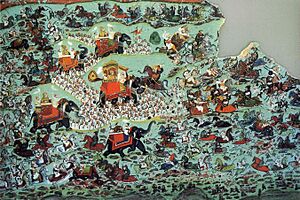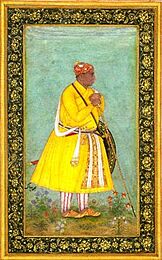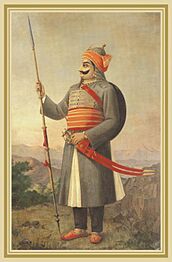Battle of Haldighati facts for kids
Quick facts for kids Battle of Haldighati |
|||||||||
|---|---|---|---|---|---|---|---|---|---|
| Part of Mughal–Rajput wars | |||||||||
 Painting of the traditional account of the battle by Chokha of Devgarh, 1822 |
|||||||||
|
|||||||||
| Belligerents | |||||||||
| Mewar Kingdom | Mughal Empire | ||||||||
| Commanders and leaders | |||||||||
|
|
|
||||||||
| Strength | |||||||||
| 3,000 cavalry 400 Bhil archers Unknown number of elephants |
10,000 men Unknown number of elephants |
||||||||
| Casualties and losses | |||||||||
| 500 dead (According to Abul Fazl) | 150 dead (According to Abul Fazl) | ||||||||
| ʽAbd al-Qadir Badayuni who was present in the battle says that 500 men were killed from both sides, of which 120 were Muslims. | |||||||||
The Battle of Haldighati was a famous fight that happened on June 18, 1576. It was fought between the forces of Mewar, led by their brave ruler Maharana Pratap, and the powerful Mughal army, led by Man Singh I of Amber. The Mughals won the battle, causing many losses for Mewar. However, they could not capture Maharana Pratap, who managed to escape with the help of his commanders.
Before this battle, in 1568, the Mughals had taken control of Chittorgarh, an important fort in Mewar. This meant the Mughals now held the fertile eastern parts of Mewar. But the rest of Mewar, with its forests and hills, was still controlled by the Sisodia family. The Mughal Emperor Akbar wanted to control Mewar to secure a safe route to Gujarat. When Pratap Singh became the king (Rana) of Mewar in 1572, Akbar sent messengers. He wanted Pratap to become a vassal, meaning he would accept Mughal rule, like many other Rajput leaders. But Pratap refused to agree to this, which eventually led to the Battle of Haldighati.
The battle took place in a narrow mountain pass called Haldighati, near Gogunda in Rajasthan. Historical records suggest that the Mughal army was much larger than Mewar's forces, possibly four times bigger. Even though Mewar's army had some early successes, the battle slowly turned against them. Maharana Pratap was wounded, and it looked like the battle was lost. Some of his loyal men, led by Jhala Man Singh, bravely fought to protect his retreat. After the battle, Man Singh of the Mughal army did not chase the retreating Mewar troops. Because of this, Emperor Akbar was upset and removed Man Singh from his court for a while.
Even after losing at Haldighati, Maharana Pratap continued to fight the Mughals using guerrilla warfare. This is a type of fighting where small groups use surprise attacks. By the time he died, he had managed to win back much of his kingdom.
Why Did the Battle Happen?
After becoming emperor, Akbar had made peace with most of the Rajput states. But Mewar, known as the most important state in Rajasthan, refused to accept Mughal rule. The ruler of Mewar, who was also the head of the respected Sisodia clan, did not want to submit to Akbar. This led to the siege of Chittorgarh in 1568, when Pratap's father, Udai Singh II, was king. Mewar lost a large, fertile area to the Mughals.
When Maharana Pratap became king, Akbar sent several diplomats to him. Akbar wanted Pratap to become his vassal. Besides solving this long-standing issue, Akbar also wanted to control Mewar's hilly land. This would help him secure important travel routes to Gujarat.
- The first messenger, Jalal Khan Qurchi, failed to convince Pratap.
- Next, Akbar sent Man Singh of Amber, a fellow Rajput. He was a very important general in the Mughal army. But he also failed to persuade Pratap.
- Raja Bhagwant Das was the third person Akbar sent. He also could not get Pratap to sign a treaty.
- Finally, Todar Mal was sent, but he also had no success.
Since diplomacy failed, war became unavoidable.
Getting Ready for Battle
Maharana Pratap had been safe in the strong fort of Kumbhalgarh. He then moved his main camp to the town of Gogunda, near Udaipur. Emperor Akbar sent Man Singh, a Kachhwa Rajput, to fight against the Sisodias of Mewar. Man Singh set up his camp at Mandalgarh. From there, he gathered his army and marched towards Gogunda.
About 14 miles (22 km) north of Gogunda was a village called Khamnor. It was separated from Gogunda by a part of the Aravalli Range mountains. This pass was called "Haldighati" because its rocks, when crushed, looked like yellow turmeric powder (haldi). Rana Pratap knew about Man Singh's movements. He positioned his army at the entrance of the Haldighati pass, waiting for Man Singh and his forces.
How Many Soldiers Fought?
Historians have different ideas about the exact number of soldiers in each army.
- Historian Satish Chandra believes Man Singh's army had between 5,000 and 10,000 men. This included both Mughal and Rajput soldiers.
- According to Al Badayuni, who was at the battle, Rana Pratap's army had 3,000 horsemen. It also had about 400 Bhil archers, led by Rana Punja.
- Man Singh's forces were estimated to be around 10,000 men. About 4,000 of these were from his own clan, the Kachhwas of Jaipur. Another 1,000 were other Hindu soldiers, and 5,000 were Muslim soldiers from the Mughal imperial army.
The Battle Begins
Maharana Pratap's attack was very strong at the beginning. It caused the Mughal army's sides and center to break apart. Abul Fazl, a historian, wrote that the Mughal army had to retreat at first. However, they soon regrouped near a place called Rati-Talai (later known as Rakt Talai).
The Mewar army followed the Mughals and attacked their left and right sides. The Mughal front line broke, but their reserve soldiers managed to hold on. Then, Man Singh himself led the Mughal rear guard into the battle. He was followed by Mihtar Khan, who started beating drums. Mihtar Khan also spread a rumor that the Emperor's army reinforcements were arriving. The Mughal musketeers (soldiers with rifles) fired their weapons, which helped stop the charge of Mewari war elephants.
This news and the strong defense boosted the Mughal army's spirits. It also made the tired Mewar soldiers lose hope. Many Mewari soldiers started leaving the battlefield. When the Mewar nobles saw that the battle was lost, they convinced the injured Rana Pratap to leave. A brave Jhala chieftain named Man Singh took Pratap's place. He put on some of Pratap's royal symbols. This made the Mughals think he was the Rana. Man Singh Jhala was eventually killed, but his brave act gave Maharana Pratap enough time to escape safely.
What Happened After the Battle?
Even though the Mughals won the battle, Man Singh did not let his army chase the retreating Mewar troops and Pratap. Some historians believe Man Singh did this out of respect for Pratap. However, Emperor Akbar was very angry with Man Singh for not capturing Pratap. He suspended Man Singh from the Mughal court for some time.
While Pratap managed to escape, the Mughal troops did capture his temporary capital, Gogunda. But they only held it for a short time. After the battle, Akbar continued his campaign against Maharana Pratap. Soon, most of Mewar was under Mughal control. The Mughals put pressure on Pratap's allies and other Rajput chiefs. This slowly isolated Pratap both geographically and politically.
After 1585 CE, the Mughals shifted their focus to other parts of their empire. This allowed Maharana Pratap to regain much of his ancestral kingdom. Records from that time show he recovered all 36 outposts of Mewar. Only Chittor and Mandalgarh remained under Mughal control.
Images for kids




